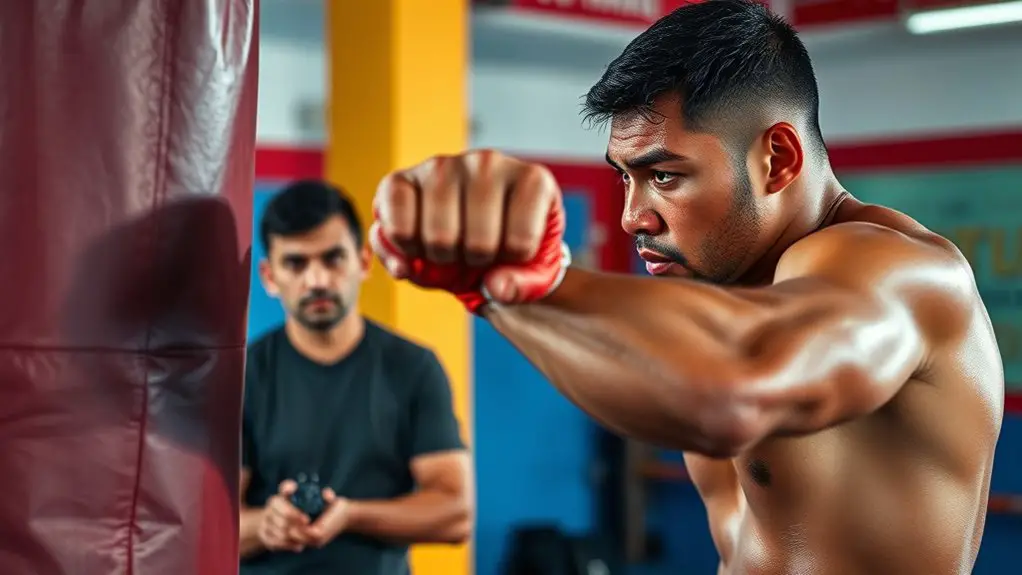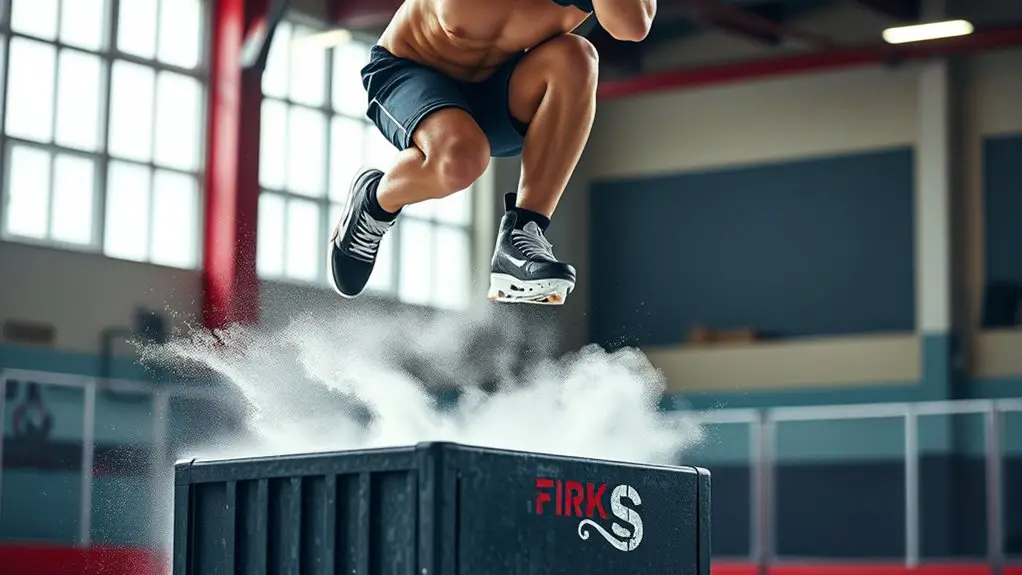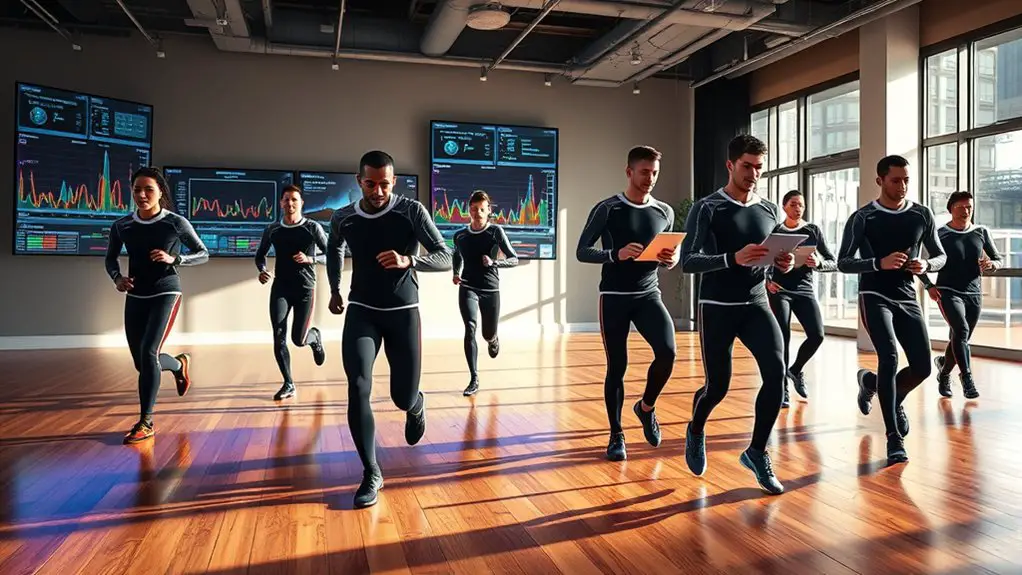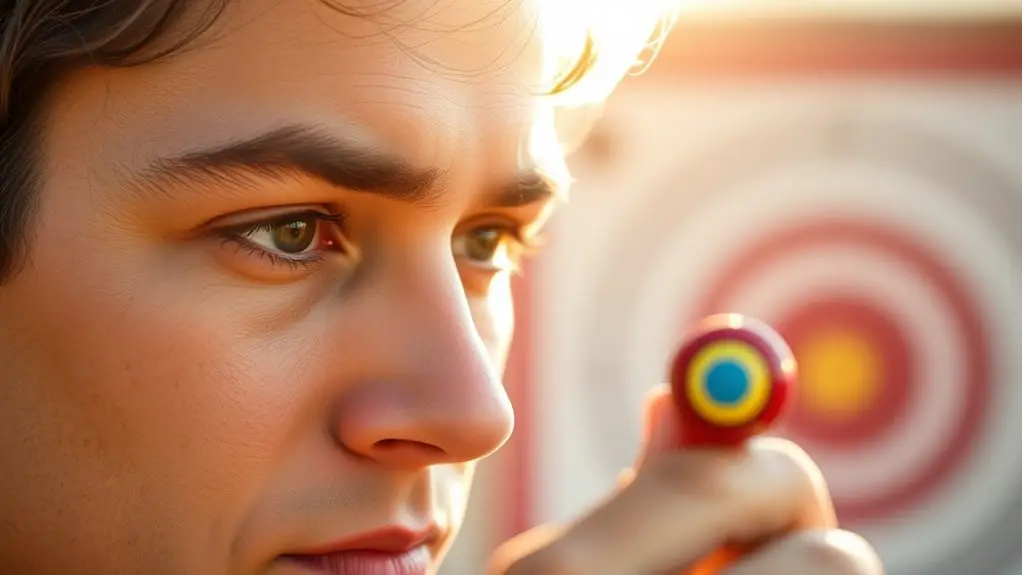To improve your balance for skateboarding and snowboarding, start by mastering weight shifting from heel to toe and side to side. Engage your core and practice dynamic stretches to enhance flexibility. Incorporating core stability exercises, like planks and balance board training, can further help. Try agility drills for coordination and yoga poses that focus on balance. With consistent practice and focus on these techniques, you'll see significant improvement in your skills, and there's more to explore.
Understanding Balance in Action Sports
When you're maneuvering through the dynamic environments of skateboarding and snowboarding, understanding balance is vital. It's all about balance mechanics and how you position your body in relation to your board. Picture yourself gliding down a slope or carving through a park; that feeling of freedom relies heavily on maintaining dynamic equilibrium. Your center of gravity plays an important role here—shift it too far forward or back, and you'll wipe out.
To stay upright, keep your knees slightly bent and your weight evenly distributed. Engage your core and stay relaxed; tension can throw you off balance. Remember, it's about fluidity and letting your instincts guide you. Practice shifting your weight from heel to toe and side to side, enhancing your ability to adapt to changing terrain. Strength training enhances muscle power for directional changes, which can also benefit your balance. Embrace the ride and let your body find that perfect balance, revealing the true essence of skateboarding and snowboarding.
Core Strength and Stability Exercises
To enhance your balance for skateboarding and snowboarding, focusing on core strength is essential. Incorporating plank variations and balance board training into your routine can greatly improve your stability. These exercises not only build core muscles but also help you maintain control on your board. Additionally, improving proprioception can enhance your body awareness, leading to quicker reactions while riding.
Plank Variations
Plank variations are essential for building core strength and stability, which are crucial for improving balance in skateboarding and snowboarding. By incorporating these exercises into your routine, you'll enhance your performance on the board. Here are three effective plank variations to try:
- Standard Plank: Hold a straight line from head to heels, engaging your core.
- Side Plank: Shift your weight to one side, stacking your feet and lifting your hips, which targets your obliques.
- Dynamic Plank: Move from a forearm plank to a high plank, alternating arms. This adds movement and challenges your stability.
Integrating these plank variations will help you feel more grounded and balanced as you ride the slopes or hit the streets. Enjoy the freedom that comes with a strong core!
Balance Board Training
While core strength is essential for maintaining balance in skateboarding and snowboarding, balance board training takes it a step further by simulating the instability of riding on a board. This training helps you develop the agility and control necessary for those thrilling rides.
Here's a quick look at balance board types and their benefits:
| Balance Board Types | Balance Board Benefits |
|---|---|
| Wobble Boards | Improves core stability |
| Roller Boards | Enhances coordination |
| Rocker Boards | Boosts overall balance |
Incorporating balance board training into your routine can elevate your skills, giving you the freedom to conquer any slope or skate park with confidence. So, grab a board and start balancing your way to success!
Balance Board Training Techniques
A balance board can be your best friend when it comes to improving your stability for skateboarding and snowboarding. By incorporating balance board training into your routine, you'll experience some awesome benefits. To really boost your skills, try these techniques:
- Static Balancing: Stand on the board with feet shoulder-width apart, focusing on keeping your balance for 30 seconds. This builds foundational strength.
- Dynamic Movement: Shift your weight side to side or front to back. This mimics the movements you'll make while riding, enhancing your control.
- Balance Board Tricks: Once you feel confident, try basic tricks like 180s or spins. This not only improves balance but also adds excitement to your training.
For peak results, aim for a training frequency of 3-4 times a week. With commitment, you'll reveal your full potential and feel the freedom on your board! Additionally, incorporating mobility training can further enhance your overall performance and reduce the risk of injury while practicing these techniques.
The Importance of Flexibility
Flexibility plays an essential role in enhancing your performance in both skateboarding and snowboarding. When you're out there carving turns or catching air, the ability to move freely can make all the difference. Dynamic stretching is key; it warms up your muscles and increases muscle elasticity, allowing you to respond swiftly to changes in terrain. Think of it as preparing your body for the wild ride ahead.
Incorporating a routine of dynamic stretches before you hit the pavement or snow will help you maintain that fluidity. You'll find that better flexibility not only improves your tricks but also helps prevent injuries. Additionally, core strength plays a crucial role in stabilizing your movements and enhancing your overall performance. So, embrace this freedom of movement; it'll give you the edge you need. With supple muscles, you'll be ready to tackle steep slopes and sharp turns, letting you enjoy every exhilarating moment of your ride.
Practicing Weight Shifting
As you navigate the board, mastering weight shifting is essential for maintaining balance and control. To help you refine your weight distribution, try these shifting techniques:
- Lean Forward or Backward: Experiment with shifting your weight toward your toes or heels. This'll help you feel how your body affects the board's movement.
- Side to Side Movements: Shift your weight from one foot to the other. This lateral movement can enhance your ability to carve turns smoothly while keeping your center of gravity balanced.
- Practice on Different Surfaces: Try weight shifting on varied terrain—flat ground, gentle slopes, or even small ramps. Each surface challenges your balance differently and builds confidence.
Utilizing Stability Trainers
Stability trainers are a great way to enhance your balance for skateboarding and snowboarding. You can explore different types, like balance boards and stability balls, to find what works best for you. Incorporating specific balance exercises into your routine will help you feel more confident on your board.
Types of Stability Trainers
There are several types of stability trainers that can enhance your balance for skateboarding and snowboarding. These trainers let you feel free while improving your skills. Here are three popular options to evaluate:
- Balance Discs: These inflatable discs create instability, forcing you to engage your core and improve your balance.
- Wobble Boards: With a pivot point that allows for rocking movements, wobble boards challenge your stability and help develop coordination.
- Bosu Balls: Combining a stability ball and a balance trainer, Bosu balls let you work on dynamic movements, building strength and agility.
Incorporating Balance Exercises
Using stability trainers can greatly enhance your balance exercises for skateboarding and snowboarding. These tools empower you to engage in dynamic movements that mimic the challenges you'll face on the board. Try balancing on a wobble board or using a Bosu ball to develop core strength and coordination. Incorporating these exercises into your routine allows you to cultivate a sense of freedom and fluidity in your rides. As you practice, focus on shifting your weight and maintaining control through various stances. This not only builds your balance but also improves your reaction time, letting you tackle obstacles with confidence. So grab your stability trainer, and let the thrill of progress elevate your skills to new heights!
Incorporating Yoga for Balance
As you explore ways to enhance your balance for skateboarding and snowboarding, incorporating yoga into your routine can be incredibly beneficial. Yoga not only strengthens your body but also improves your breath control, helping you find your center on the board. Here are three key yoga poses to try:
Incorporating yoga into your routine can greatly enhance balance and breath control for skateboarding and snowboarding.
- Tree Pose: This pose helps develop stability by focusing on one leg while grounding the other.
- Warrior III: This dynamic pose enhances your balance and core strength, making it easier to maintain your posture while riding.
- Chair Pose: Engaging your muscles in this pose builds endurance and control, which translates to better performance on your board. Additionally, incorporating poses like Downward-Facing Dog can enhance blood circulation, speeding up recovery and improving overall stability.
Agility Drills for Enhanced Coordination
While practicing yoga can lay a solid foundation for balance, integrating agility drills into your training routine further enhances your coordination, which is essential for skateboarding and snowboarding. These dynamic movement drills not only get your heart pumping but also improve your body's responsiveness. Try ladder drills to sharpen foot speed and coordination or cone drills that require quick changes in direction.
Incorporate reaction time exercises like partner games, where you respond to unexpected cues. This not only hones your agility but also prepares you for the unpredictable nature of the slopes or skate parks. Consistency in practice is key to achieving significant improvements in your agility and coordination.
As you build these skills, you'll feel more in control, allowing you to express yourself freely on your board. Embrace the challenge of agility drills, and watch how they transform your ride, giving you that exhilarating sense of freedom you crave.
Visual and Spatial Awareness Training
To enhance your performance in skateboarding and snowboarding, developing visual and spatial awareness is essential. This skill helps you navigate your environment and react to obstacles with ease. Here are three ways to boost your visual and spatial awareness:
- Depth Perception Drills: Practice identifying distances and heights, helping you gauge jumps and landings better.
- Obstacle Navigation Exercises: Set up a course with varied obstacles to improve your body orientation and movement anticipation.
- Visual Perception Games: Engage in activities that challenge your sensory integration, like catching a ball while moving.
Progress Tracking and Goal Setting
To really improve your balance, you need to set specific goals that challenge you. Regularly monitoring your progress helps you see how far you've come and where you need to focus. Don't forget to adjust your targets as you develop; flexibility is key to continuous improvement. Additionally, using the SMART criteria for goal setting can provide clarity and direction in your balance training journey.
Set Specific Goals
Setting specific goals is essential for tracking your progress and enhancing your skills in skateboarding and snowboarding. When you visualize your goals, it opens up the path to achieving them. Break down your journey into specific milestones to keep you motivated. Here are three goals to contemplate:
- Master a New Trick: Choose a trick you've been eyeing and dedicate time each week to practice it.
- Balance Drills: Set a goal to complete a certain number of balance drills each session, focusing on improving your core stability.
- Ride Different Terrains: Challenge yourself to ride on varied surfaces or slopes to expand your skill set.
With each milestone you hit, you'll feel that exhilarating freedom of progress!
Monitor Progress Regularly
Regularly monitoring your progress is key to staying motivated and making meaningful improvements in your skateboarding and snowboarding journey. By incorporating progress tracking into your routine, you can assess how far you've come and identify areas for growth. Set aside time each week to reflect on your goals and record your achievements.
| Week | Skills Practiced | Progress Assessment |
|---|---|---|
| Week 1 | Balance on board | Can hold for 5 seconds |
| Week 2 | Ollies | Landed 3 out of 10 times |
| Week 3 | Carving | Improved smoothness |
This table allows you to visualize your journey. Remember, goal assessment isn't just about hitting targets; it's about enjoying your ride and embracing every step of the way.
Adjust Targets Accordingly
As you track your progress, it's important to adjust your targets to reflect your evolving skills and confidence. Embracing target adjustments can truly enhance your journey in skateboarding and snowboarding. Here are three key areas to focus on for effective skill refinement:
- Assess Your Current Level: Identify where you stand regarding balance and agility.
- Set Realistic Goals: Create achievable milestones that challenge you without overwhelming you.
- Celebrate Small Wins: Acknowledge every improvement, no matter how minor, to maintain motivation and a sense of freedom.
Frequently Asked Questions
What Footwear Is Best for Improving Balance in Skateboarding and Snowboarding?
When it comes to footwear selection, you'll want shoes that offer excellent grip technology. Look for soles made of rubber with deep treads, as they provide the traction you need for ideal control. A snug fit can also enhance your connection with the board, allowing for better balance. Don't forget to take into account flexibility; a comfortable, lightweight shoe lets you feel free while riding, letting you fully enjoy the experience without restriction.
How Does Diet Affect Balance Performance in Action Sports?
Your diet plays an essential role in your balance performance in action sports. By focusing on nutrition timing, you can fuel your body effectively before and after sessions, ensuring you've got the energy and stamina to maintain stability. Don't forget hydration effects, either; staying well-hydrated helps keep your muscles functioning at their best, enabling you to feel free and in control. So, prioritize your nutrition, and you'll notice improvements in your balance and overall performance.
Can Age Impact Balance Abilities in Skateboarding and Snowboarding?
Absolutely, age can impact your balance abilities. As you get older, natural aging effects can lead to decreased muscle strength and coordination, which might affect your performance in action sports. However, that doesn't mean you can't improve! Incorporating balance training into your routine can help counteract these effects. Embrace the freedom of movement, and with dedication, you can maintain or even enhance your balance, no matter your age. Keep pushing your limits!
Are There Specific Warm-Up Routines to Enhance Balance Before Riding?
Imagine you're gearing up for an epic day on your board, but first, you wanna warm up to enhance your balance. Try a routine that includes dynamic stretching and yoga poses. Start with leg swings to loosen your hips, then shift into a tree pose for stability. This'll not only prepare your body but also help you feel more grounded and free when you hit those thrilling slopes or streets.
How Do Mental Strategies Influence Balance During Skateboarding and Snowboarding?
Mental strategies play a huge role in your balance. By using visualization techniques, you can imagine yourself gliding smoothly, which helps build confidence and stability. Focus exercises, like concentrating on your breathing or the rhythm of your movements, can ground you in the moment. When you're fully engaged mentally, you're more in tune with your body, allowing for that sense of freedom you crave while riding. Embrace these strategies to enhance your balance!




